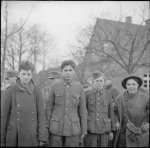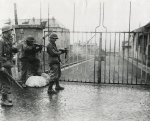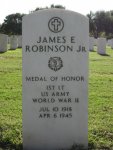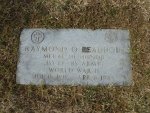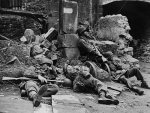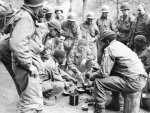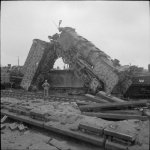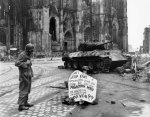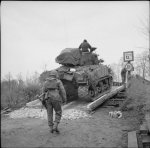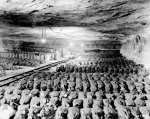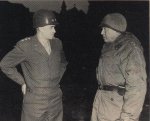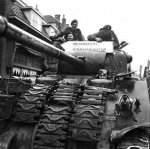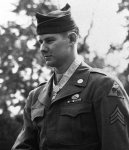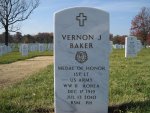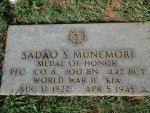April 6, 1945: On the western front, British 2nd Army forces attack toward Bremen. US 9th Army crosses the Weser River near Minden and continues to attack the Ruhr pocket along with US 1st Army. Elements of US 1st Army also push toward Northeim and Duderstadt. US 3rd Army captures Grossalmerode, Trubenhausen, Bad Sooden, Langensalza, and Eisenach while US 7th Army pushes toward Schweinfurt and attacks into Heilbronn. French 1st Army attacks around Pforzheim.
15,000 prisoners of Buchenwald Concentration Camp in Germany are evacuated by German authorities as US 3rd Army pushes ever closer.
Serving in Battery A, 861st Field Artillery Battalion, 63rd Infantry Division, First Lieutenant James E. Robinson, Jr. led his company in an attack against German lines near Untergriesheim, Germany. Although severely wounded, he refused medical attention and continued on until the objective had been taken. He died of his wounds later that day. He was posthumously awarded the Medal Of Honor on December 11, 1945 - here is his citation:
“He was a field artillery forward observer attached to Company A, 253d Infantry, near Untergriesheim, Germany, on 6 April 1945. Eight hours of desperate fighting over open terrain swept by German machinegun, mortar, and small-arms fire had decimated Company A, robbing it of its commanding officer and most of its key enlisted personnel when 1st Lt. Robinson rallied the 23 remaining uninjured riflemen and a few walking wounded, and, while carrying his heavy radio for communication with American batteries, led them through intense fire in a charge against the objective. Ten German infantrymen in foxholes threatened to stop the assault, but the gallant leader killed them all at point-blank range with rifle and pistol fire and then pressed on with his men to sweep the area of all resistance. Soon afterward he was ordered to seize the defended town of Kressbach. He went to each of the 19 exhausted survivors with cheering words, instilling in them courage and fortitude, before leading the little band forward once more. In the advance he was seriously wounded in the throat by a shell fragment, but, despite great pain and loss of blood, he refused medical attention and continued the attack, directing supporting artillery fire even though he was mortally wounded. Only after the town had been taken and he could no longer speak did he leave the command he had inspired in victory and walk nearly 2 miles to an aid station where he died from his wound. By his intrepid leadership 1st Lt. Robinson was directly responsible for Company A's accomplishing its mission against tremendous odds.â€Â
Robinson, 26 at death, was buried in Fort Sam Houston National Cemetery, San Antonio, Texas.
First Lieutenant Raymond O. Beaudoin, serving in Company F, 119th Infantry, 30th Infantry Division, was leading his platoon over open ground when all were pinned down by a devastating curtain of fire from enemy machineguns and automatic weapons. By rotating his men in firing position he enabled his platoon to dig in against the numerically superior force and inflict heavy casualties on it. However, enemy reinforcements made the platoon’s position precarious. In order to allow a runner to secure help, Lieutenant Beaudoin decided to make a one man charge on the most dangerous sniper nest some 90 yards (82 m) away. Despite a barrage of rifle and bazooka fire he reached the nest and wiped out three of its inhabitants, the fourth falling from covering fire from the American platoon. Continuing the attack, Lieutenant Beaudoin charged a dugout, but was killed by a blast of machinegun fire. The runner was able to secure help, however; and the platoon was saved. For the supreme sacrifice which he made in saving the lives of the men under him, Lieutenant Beaudoin was posthumously awarded the Medal of Honor. here is his citation:
“He was leading the 2d Platoon of Company F over flat, open terrain to Hamelin, Germany, when the enemy went into action with machineguns and automatic weapons, laying down a devastating curtain of fire which pinned his unit to the ground. By rotating men in firing positions he made it possible for his entire platoon to dig in, defying all the while the murderous enemy fire to encourage his men and to distribute ammunition. He then dug in himself at the most advanced position, where he kept up a steady fire, killing 6 hostile soldiers, and directing his men in inflicting heavy casualties on the numerically superior opposing force. Despite these defensive measures, however, the position of the platoon became more precarious, for the enemy had brought up strong reinforcements and was preparing a counterattack. Three men, sent back at intervals to obtain ammunition and reinforcements, were killed by sniper fire. To relieve his command from the desperate situation, 1st Lt. Beaudoin decided to make a l-man attack on the most damaging enemy sniper nest 90 yards to the right flank, and thereby divert attention from the runner who would attempt to pierce the enemy's barrier of bullets and secure help. Crawling over completely exposed ground, he relentlessly advanced, undeterred by 8 rounds of bazooka fire which threw mud and stones over him or by rifle fire which ripped his uniform. Ten yards from the enemy position he stood up and charged. At point-blank range he shot and killed 2 occupants of the nest; a third, who tried to bayonet him, he overpowered and killed with the butt of his carbine; and the fourth adversary was cut down by the platoon's rifle fire as he attempted to flee. He continued his attack by running toward a dugout, but there he was struck and killed by a burst from a machinegun. By his intrepidity, great fighting skill, and supreme devotion to his responsibility for the well-being of his platoon, 1st Lt. Beaudoin single-handedly accomplished a mission that enabled a messenger to secure help which saved the stricken unit and made possible the decisive defeat of the German forces.â€Â
Beaudoin was buried in a family plot in Notre Dame Cemetery in South Hadley, MA
On the Island of Texel off the Dutch coast, the Georgian troops serving as volunteers with the German army mutiny. Some 246 German troops are killed in their sleep by the Georgians (most of whom had originally been captured on the Eastern Front) and a battle breaks out which eventually results in 800 Germans, 500 Georgian and 117 Texel civilian fatalities. The fighting ends only when the Canadians arrive on May 20, 1945 - some two weeks after the end of the European war.
Above Germany, US 8th Air Force attacks Leipzig with 321 bombers, Halle with 183 bombers, and targets of opportunity with 33 bombers.
In East Prussia, after six days of artillery and aerial bombardment, the Soviet 3rd Belorussian Front begins its final attacks on Konigsberg - 137,000 Soviet troops rush into the city, supported by 530 tanks and 2,400 aircraft. To the south, forces of the 3rd Ukrainian Front enter the suburbs of Vienna. Yugoslavian forces capture Sarajevo.
Reich Minister of Propaganda Joseph Goebbels announces that a German victory is to come during this month and only Adolf Hitler knows the moment. He obtained this information from astrology.
Artillery preparation for the Allied Operation Grapeshot - an attack by US 5th Army, British 8th Army and Brazilian Expeditionary Force into the Lombardy Plain - begins in northern Italy. British 8th Army attacks across the Reno River while US 5th Army attacks around Massa, Monte Cerreta, and Monte Belvedere. US 12th Air Force aircraft attack transportation lines and other targets in the Po valley and throughout northern Italy, including support for ground operations around Massa Lombarda. US 15th Air Force also attacks Verona and Brescia with 387 bombers and bridges near German border with 14 fighters.
Pictured: Young German POWs captured by Guard's Armoured Division, April 6, 1945.; GIs of the 62nd Armored Infantry, 14th Armored Division, make their way through the ruins of Gemünden on April 6,1945.; US soldiers break into the gates of the German POW camp Oflag XIII-B in Hammelburg on April 6, 1945.; Grave of Medal Of Honor recipient James Robinson.; Grave of Medal Of Honor recipient Raymond Beaudoin.
